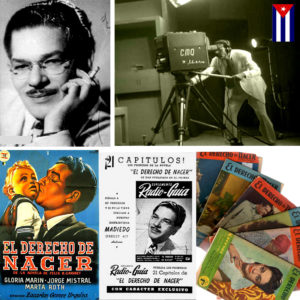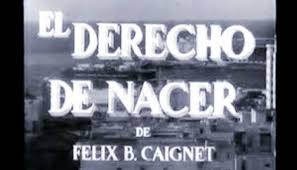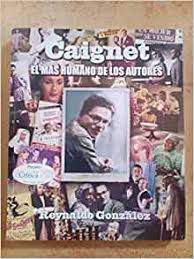 FÉLIX B. CAIGNET “EL PADRE DE LAS TELENOVELAS”, POETA, NOVELISTA, COMPOSITOR. VIDEOS.
FÉLIX B. CAIGNET “EL PADRE DE LAS TELENOVELAS”, POETA, NOVELISTA, COMPOSITOR. VIDEOS.
Félix Benjamín Caignet Salomón, conocido como Félix B. Caignet, nació en una plantación de café en Santa Rita de Burene, San Luis, en la región oriental de Cuba. La pobreza obligó a la familia a trasladarse a Santiago de Cuba. Caignet fue un radionario, locutor, poeta, novelista, periodista, crítico de teatro, cantante y compositor musical cubano.
Es conocido como pionero de la radiodifusión en Cuba y el padre de las telenovelas (culebrones) que atrapan a muchos frente a las pantallas de la television.
Caignet creía que el público “asumía los sentimientos de uno u otro personaje que sufría y, sin darse cuenta, asociaba su propio dolor con el de la figura ficticia y lloraba con él”.
Los dramas de radio de Caignet se transmitieron a través de América Central y del Sur y llevaron a la popularidad historias de la realidad social y el estilo narrativo de “hablar en metáforas”.
Su formación fue completamente autodidacta. Muy temprano comenzó a laborar escribiendo noticias de los espectáculos que se presentaban en Santiago, introduciéndose así en el medio cultural. Más tarde escribiría para medios tan populares como “El diario de Cuba”, “El Fígaro”, “Bohemia” y el periódico “El Sol”.
En la década de 1930 entra a formar parte del colectivo de la emisora CMKC, realizando el programa infantiles, donde acometió la narración de amenos y divertidos cuentos de su inspiración y de temáticas muy desiguales.
radio. Aquel espacio llevaba un alto contenido didáctico. Y fue así como introdujo en la radio el “género episódico”, enganchando a sus jóvenes oyentes con la curiosidad de saber cómo continuarían aquellas historias. Una fórmula vigente aún hoy en dia. Fue entonces que comenzaron a aparecer programas para niños en la radio, pues hasta entonces no habían visto interés comercial en este tipo de espacios.
De regreso a este medio, a través de la CMKD del Palacio de la Torre, inicia las transmisiones de “Chan-Li-Po”, primer espectáculo seriado detectivesco que se radiaba en Cuba. El primero de los capítulos llevó por nombre “La serpiente roja”, introduciendo la figura el “narrador” dentro del espectáculo radial, adquiriendo un dominio pleno del suspenso y el falso suspenso; dejando a miles de radioyentes con la ansiedad de escuchar el próximo capítulo. Con esta técnica fue creando hábitos en los radioescuchas.
Hay que destacar que en el ámbito radiofónico tuvo un antecedente importante, pues la primacía le correspondió a José Sánchez Arcilla, periodista, dramaturgo, comediógrafo y hasta el autor de los libretos de numerosas zarzuelas cubanas, entre las que se destacan “Cecilia Valdés” y “El Clarín”. La radionovela en cuestión, “El Collar de Lágrimas”, difundida por más de tres años entre lunes y sábado, culminó sus 965 capítulos, el 31 de diciembre de 1946.
En 1947, Caignet tuvo una idea brillante. Mezcló todos estos ingredientes, pero añadiendo un fondo sentimental. Y ya en 1948, comienza a radiarse la reconocida internacionalmente como primera “radionovela” de Latinoamérica, “El derecho de nacer”, la que se convertiría en paradigma para este género que aquí nacía, en esta radio de una ciudad cubana, y que se extendería rápidamente a otras naciones del continente, y el mundo, y que sirviera de base para el nacimiento de las telenovelas, que más tarde, con su prolongada extensión de interés puramente comercial, llegarían a ser llamadas “culebrones”.
NACIMIENTO DE LA TELENOVELA EN CUBA.
“El derecho de nacer”, se estrenó en Cuba el 1 de abril de 1948. En 1952, para la radio se hicieron dos versiones internacionales y otra en 1966. Los primeros en llevar “O Direito do Nascer” a la televisión fueron los brasileños, en 1964, con episodios desconocidos. Después de su muerte se realizaron dos versiones televisivas en español (1981 y 2001), y dos en portugués (1978 y 2001).
Nuestra primera telenovela fue “Mamá”, obra teatral de Gregorio Martínez Sierra y adaptación de Leandro Blanco, que fue llevada a nuestra pantalla por el Canal 6 de CMQ-TV. Su premiere se realizó el 7 de mayo de 1958 y se difundió en directo al aire, “en vivo”, entre el 12 de mayo de 1958 hasta el Miércoles, 31 de agosto de 1962, con una frecuencia de tres veces a la semana que culminaban el bloque de programación de entretenimiento del canal, precediendo al Noticiero con que esa televisora cerraba sus transmisiones.
Las transmisiones comerciales de televisión comenzaron en Cuba el 24 de octubre de 1950, pero hubo transmisiones extraoficiales a finales de los 40 y en el propio año de apertura. En México, se habían realizado experimentos en televisión a partir de 1934, pero la puesta en funcionamiento de la primera estación de TV, Canal 5, en la Ciudad de México, tuvo lugar en 1946. Cuba fue el segundo país del mundo en transmitir a color.
 FELIX B. CAIGNET “THE FATHER OF TELENOVELAS”, POET, NOVELIST, COMPOSER. VIDEOS.
FELIX B. CAIGNET “THE FATHER OF TELENOVELAS”, POET, NOVELIST, COMPOSER. VIDEOS.
Félix Benjamín Caignet Salomón, known as Félix B. Caignet, was born on a coffee plantation in Santa Rita de Burene, San Luis, in the eastern region of Cuba. Poverty forced the family to move to Santiago de Cuba. Caignet was a Cuban radiographer, broadcaster, poet, novelist, journalist, theater critic, singer, and musical composer.
He is known as a pioneer of radio broadcasting in Cuba and the father of telenovelas (soap operas) that catch many in front of television screens.
Caignet believed that the public “assumed the feelings of one or another suffering character and, without realizing it, associated their own pain with that of the fictitious figure and cried with it.”
Caignet’s radio dramas were broadcast throughout Central and South America and brought stories of social reality and the narrative style of “speaking in metaphors” to popularity.
His training was completely self-taught. Very early he began to work writing news of the shows that were presented in Santiago, thus introducing himself in the cultural environment. Later he would write for such popular media as “El Diario de Cuba”, “El Fígaro”, “Bohemia” and the newspaper “El Sol”.
In the 1930s, he became part of the CMKC station collective, carrying out the children’s program, where he narrated entertaining and entertaining stories of his inspiration and very uneven themes.
radio. That space had high didactic content. And that was how he introduced the “episodic genre” on the radio, hooking his young listeners with the curiosity of knowing how those stories would continue. The formula is still valid today. It was then that children’s programs began to appear on the radio because until then they had not seen commercial interest in this type of space.
Back in this medium, through the CMKD of the Palacio de la Torre, he began the broadcasts of “Chan-Li-Po”, the first detective serial show that was broadcast in Cuba. The first of the chapters was called “The Red Serpent”, introducing the figure of the “narrator” into the radio show, acquiring a full command of suspense and false suspense; leaving thousands of listeners anxious to hear the next chapter. With this technique, he was creating habits in radio listeners.
It should be noted that in the radio field it had an important antecedent since the primacy corresponded to José Sánchez Arcilla, journalist, playwright, comediographer and even the author of the librettos of numerous Cuban zarzuelas, among which “Cecilia Valdés” and “The clarin”. The radio soap opera in question, “El Collar de Tgrimas”, broadcast for more than three years between Monday and Saturday, ended its 965 episodes, on December 31, 1946.
In 1947, Caignet had a brilliant idea. He mixed all these ingredients but adding a sentimental background. And already in 1948, the internationally recognized as the first “radio soap opera” of Latin America, “The right to be born”, began to be broadcast, which would become a paradigm for this genre that was born here, in this radio of a Cuban city, and that was it would quickly spread to other nations of the continent, and the world, and serve as the basis for the birth of soap operas, which later, with their long extension of purely commercial interest, would come to be called “soap operas.”
BIRTH OF THE TELENOVELA IN CUBA.
“The right to be born” premiered in Cuba on April 1, 1948. In 1952, two international versions were made for the radio and another in 1966. The first to bring “O Direito do Nascer” to television were the Brazilians, in 1964, with unknown episodes. After her death, two television versions were made in Spanish (1981 and 2001), and two in Portuguese (1978 and 2001).
Our first telenovela was “Mamá”, a play by Gregorio Martínez Sierra and adaptation by Leandro Blanco, which was brought to our screen by Channel 6 of CMQ-TV. Its premiere took place on May 7, 1958, and was broadcast live on the air, “live”, from May 12, 1958, to Wednesday, August 31, 1962, with a frequency of three times a week that they culminated the channel’s entertainment programming block, preceding the Newscast with which that television station closed its transmissions.
Commercial television broadcasts began in Cuba on October 24, 1950, but there were unofficial broadcasts in the late 1940s and in the opening year itself. In Mexico, television experiments had been carried out since 1934, but the first TV station, Channel 5, was launched in Mexico City in 1946. Cuba was the second country in the world to broadcast to Colour.
Agencies/ Wiki/ MemoriasCubanas/ Derubín Jácome/ Extractos/ Excerpts/ Internet Photos/ YouTube/ Arnoldo Varona/ www.TheCubanHistory.com
THE CUBAN HISTORY, HOLLYWOOD.











